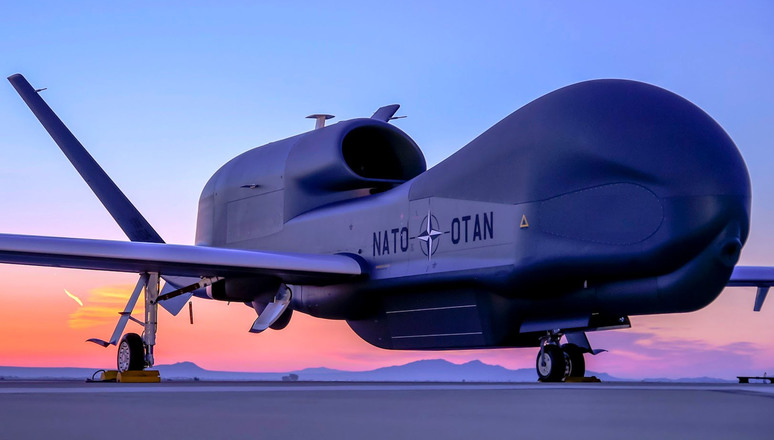Our World is an Unsafe Place
"NATO faces the most complex security environment since the end of the Cold War. Russia's behaviour remains assertive and destabilising, and terrorism continues to represent a global security challenge and a threat to stability. At the same time, the rise of China is shifting the global balance of power, with implications for the Alliance's security, values and way of life. Growing global uncertainty, more sophisticated and disruptive cyber and hybrid threats, and exponential technological change are having a substantial impact on the Alliance.""Russia's aggressive actions, including the threat and use of force to attain political goals, challenge the Alliance and undermine Euro-Atlantic security and the rules-based international order. Russia has become more assertive with its illegal and illegitimate annexation of Crimea (2014), the destabilisation of eastern Ukraine, its military build-up close to NATO's borders, its hybrid actions, including disinformation campaigns, and its malicious cyber activities."North Atlantic Treaty Organization

"It has not been more difficult since the end of the Cold War.""We still have avenues and channels for communications with Russia, but we regret the Russian decision to close the two NATO offices in Moscow, and to also stop their activity at that NATO mission here at NATO.""NATO's approach to Russia remains the same as before, meaning credible deterrence and defense, combined with efforts to have a meaningful dialogue with Russia."Jens Stoltenberg, Secretary-General, NATO"This isn't new behavior [on Moscow's part].""This is the way of deterrence [the 30-member NATO agreed-upon plan]."."And this is being adapted to the current behavior of Russia -- and we are seeing violations particularly of the air space over the Baltic states, but also increasing incursions over the Black Sea."German Defense Minister Annegret Kramp-Karrenbauer
The
Kremlin and Russian President Vladimir Putin have long been placed on
notice. That occurred when Russian troops violated Georgia's sovereign
border and facilitated two breakaway provinces to declare their
intentions and re-occurred when ethnic Russian Ukrainians in eastern
Ukraine declared their independence from Kyiv and the reassignment of
allegiance to the Russian Federation. 'Invisible' Russian troops were
there to help and encourage them.
And
when Russia appropriated the Crimean Peninsula, annexing it as an
integral, traditional, historical part of Russia's beating heart, NATO
called on its members to pledge their participation -- more symbolic
than conflict-ready -- in troops to be stationed in the near-abroad of
former Soviet satellites to ensure the Kremlin understood the message,
loud and clear. NATO on the periphery of Russian geography, giving
assurances to concerned Baltic states.
And
now a new master plan to defend eastern Europe against potential
attacks on presumed multiple fronts. Moscow issuing territorial threats
on land, sea and air, a repetition of Beijing's behaviour in the South
China Sea, the Himalaya, its contesting of disputed geographic claims
with its neighbours. One focus at a time. The strategy's purpose is in
preparation for a presumed attack, simultaneously in the Baltic and
Black Sea regions by a nuclear-armed, belligerent, former world power.
"We continue to strengthen our alliance with better and modernized plans",
NATO's Jens Stoltenberg assured Europe, with an added approval of a
fund for the development of new digital technologies, in a world where
cyber attacks are increasingly becoming the new and preferred mode of
intimidation, threat and cyber-war. (Think Estonia) Strictly
proactive, preventive, not in reaction necessarily to a presumed
near-pending conflict by a Russia which denies intentions of any
aggression, accusing NATO itself of fomenting a destabilizing
atmosphere.
 |
| Uran-9 combat unmanned ground vehicle. Image: Vitaly V. Kuzmin/vitalykuzmin.net |
The Concept for Deterrence and Defence in the Euro-Atlantic Area,
the new strategic master plan, has the approval of European diplomats
to NATO who agree that its strategic implementation is a requirement in
the face of Russian development of advanced weapons systems, while
deploying troops closer to the borders of NATO's allies. A
nervous-making gesture if any were needed, to validate the necessity of
such a deterrent plan-of-action.
More
detailed regional plans will be formulated by the final days of 2022,
according to an American official, where NATO will determine what
further weapons are required and how best its forces are to be
positioned. Russia amassed a staggering 100,000 troops on Ukraine's
border in May, simulating an invasion scenario, a theatrical tease with
sinister overtones. New combat robots were deployed in military drills
in September with Belarus, further alarming the Baltic states.
The
Kremlin's determination in advancing Soviet military space systems
could have the potential to attack orbiting satellites as it develops
artificial intelligence technologies that could disrupt allied command
systems. In 2018 "super weapons" were unveiled, including
nuclear-capable hypersonic cruise missiles capable of evading
early-warning systems. Provocative, intimidating, assertive and needful
of responsive recognition.
"Russia is pursuing the incremental integration of asymmetric force-multiplier technologies into its established and legacy weapons systems. Meanwhile, the defence industry is developing new systems and capabilities in military robotics and has successfully integrated unmanned vehicles, particularly aerial drones, into its military operations. In the space sector, Russia is pursuing the development of capabilities able to potentially counter and disrupt an adversary’s satellite operations. Finally, AI technologies are being developed with a view to the disruption of Western command and control systems and communication facilities, as well as the establishment of information superiority."Chatham House

Labels: Geographic Expansion, Intimidation, NATO, Russia, Sovereignty Threats

<< Home